This post may contain affiliate links. Read more at our disclosure policy.
Grilled Balsamic Glazed Chicken takes a whole new level in flavor when savory grilled chicken is coated with rosemary and balsamic glaze. This makes a great stand alone meal or can be used as a base for a salad. Either way, it’s delicious.
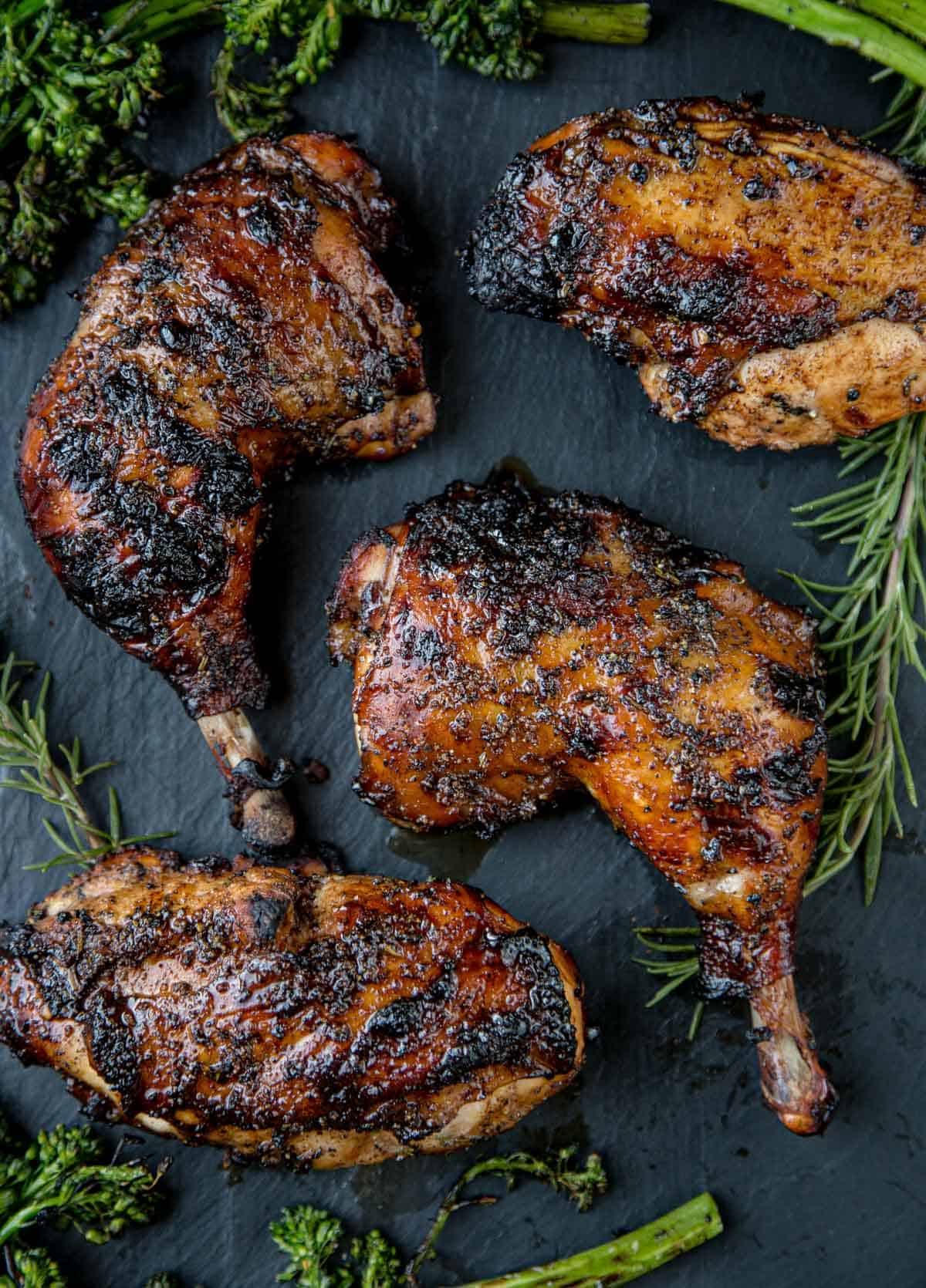
There’s no such thing as too many grilled chicken recipes. This one takes some of my favorite flavors (rosemary, aged balsamic vinegar, and honey, to name a few), and turns those into a sweet and savory glaze for grilled chicken. There are some big and bold flavors in this dish. Even the kiddos love this one!
Table of Contents
Ingredients
- Chicken – We prefer whole chicken legs which are bone-in chicken thighs and chicken drumstick and a bone-in chicken breast. The skin crisps up nicely. You can use any cut of chicken, bone-in or boneless. If buying the chicken – you can have the butcher cut up a whole chicken or buy the separate pieces.
- Olive Oil – A light amount of olive oil helps the seasoning bind to the meat.
- Seasoning – We are using our chicken rub which is a combination of kosher salt, pepper, and dried herbs for a savory flavor. Alternatively you can use our all-purpose rub with a little sugar in it. Or use your favorite store-bought seasoning.
- Balsamic Glaze – We reduce the following ingredients: shallots, garlic, balsamic vinegar, brown sugar, soy sauce, honey, fresh rosemary, grated ginger, and kosher salt.
Portions are in the recipe card.
Preparation
- Start by making the balsamic glaze so it can set and thicken up prior to the chicken being grilled.
- Then season the raw chicken with poultry seasoning. Our seasoning is a blend of herbs and savory flavors that makes chicken really stand out. You can also use your favorite poultry rub. Do this up to 24 hours prior to grilling. The longer the rub adheres to the chicken the stronger the flavor as the salt helps brine the meat.
- The last step is to grill and glaze the chicken.
Rosemary Balsamic Glaze
A basic balsamic glaze adds a sweet and rich flavor. The goal is to combine the balsamic vinegar with sugar and then apply heat. The heat will allow the balsamic to reduce as it simmers, intensifying in flavor. In addition to intensifying the flavor, the sauce will also thicken up which makes it a great thick glaze for the meat.
- In a small sauce pan over medium heat, add olive oil and shallot. Stir often so as to not burn the shallots. This should take about 4 minutes. Add garlic and sauté an additional 1 minute.
- Add remaining glaze ingredients in the pan and stir to incorporate. Bring heat up to medium high and a simmer. Continue to simmer the glaze for an additional 20 minutes or until the glaze has reduced in half.
- Remove the glaze from the heat and allow to cool. As the glaze cools, it will thicken up with the flavors getting more intense. You can place in the refrigerator until ready to use. We recommend doing this prior to starting the grill so it has enough time to cool and thicken up.
How To Grill Balsamic Glazed Chicken
If you are intimidated by chicken then check out our full summary of how to grill perfect chicken every time. Most people overcook grilled chicken for fear of getting sick. But using a two-zone method of grilling allows you to get the sear on the skin and still result in a juicy piece of chicken that is not overcooked.
- Remove from chicken if there is any. Coat chicken olive oil and liberally apply the poultry seasoning. This step can be done up to 24 hours prior to cooking.
- Prepare the grill for two-zone cooking method, targeting 450 – 500 degrees ambient cooking temperature in the grill.
- Place the chicken over direct heat on the grill and cook until it gets a nice sear (about 4 minutes with the lid closed). Flip the chicken and grill the other side over direct heat for an additional 4 minutes with the lid closed to get a nice sear. Then move the chicken to indirect heat.
- Continue to grill over indirect heat with the lid closed. When the chicken reaches an internal temperature of 150 degrees Fahrenheit (about 8 minutes), glaze the chicken once. Continue to grill indirect and remove from grill when the internal temperature of chicken is at least 160 degrees Fahrenheit using an instant read thermometer.
- Immediately glaze the chicken one last time and let rest 10 minutes loosely tented with foil. Serve with your favorite side.
Recipe Note: We glaze toward the end of the cooking process because the glaze will burn over direct heat.
Would you like to save this?
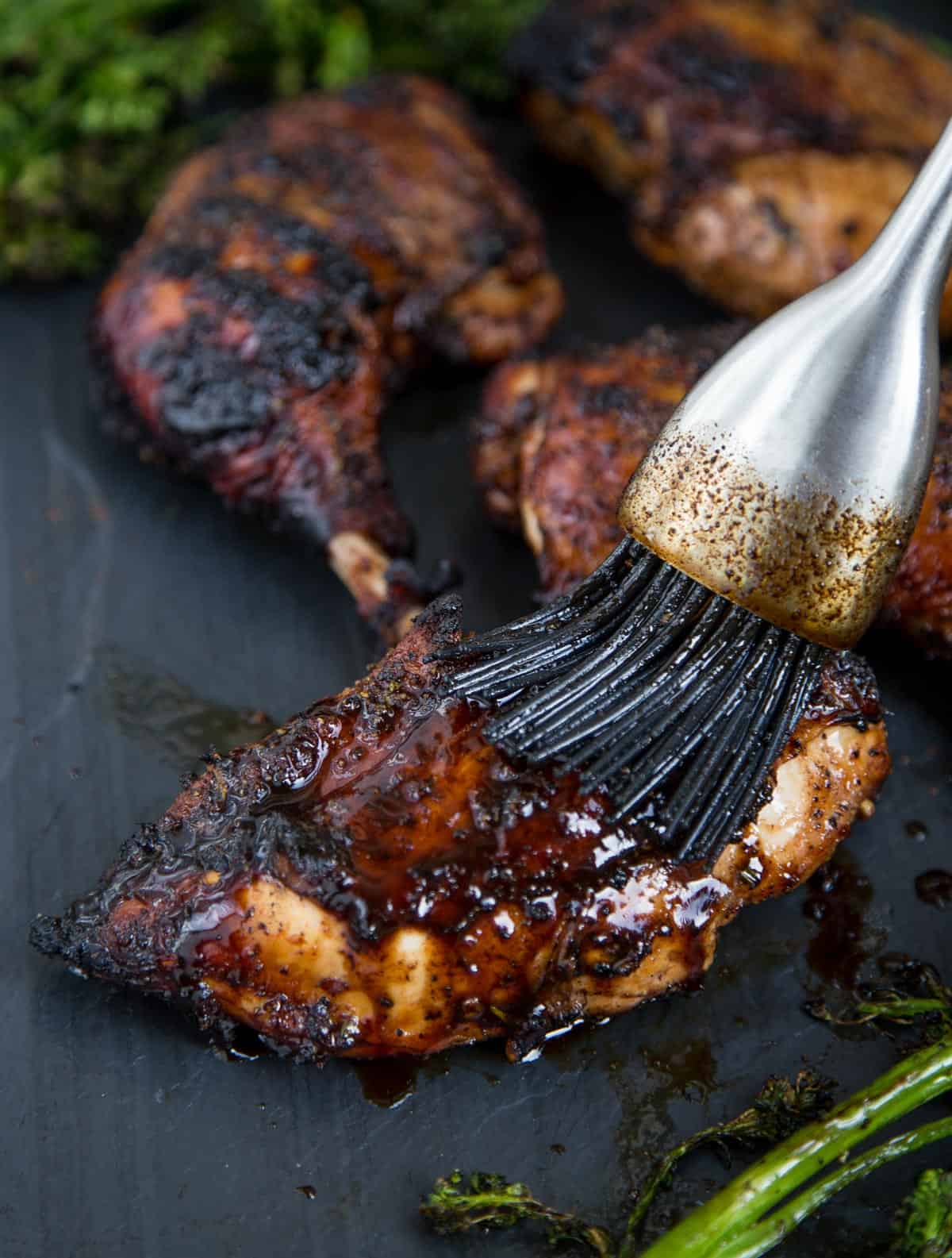
Making Ahead + Storage
You can make the balsamic glaze the day prior. It will thicken as it cools. If it thickens too much, put back over heat with some water and stir as it warms.
You can season the chicken the day prior to cooking.
If you have leftover we recommend reheating in the oven on a sheet tray at 300 degrees until the internal temp of the chicken is 150 degrees.
When Is the Chicken Done?
USDA recommends cooking chicken to at least 165 degrees Fahrenheit to safely cook out any pathogens. This will mean that you need to monitor the chicken to move from direct to indirect when you see a nice sear and allow the indirect heat to finish the chicken.
Take the temperature of each piece in the thickest part of the chicken, as some will be done sooner than others, using a good high quality instant read thermometer like the Thermoworks Thermapen One. After you remove the chicken from heat, carry over cooking will occur allowing the chicken to continue to increase in temperature up to 5 degrees Fahrehneit.
- Our preferred temperature for chicken breast is 160 degrees Fahrenheit.
- For chicken thighs and drumsticks we like to pull the chicken between 170 – 175 degrees Fahrenheit.
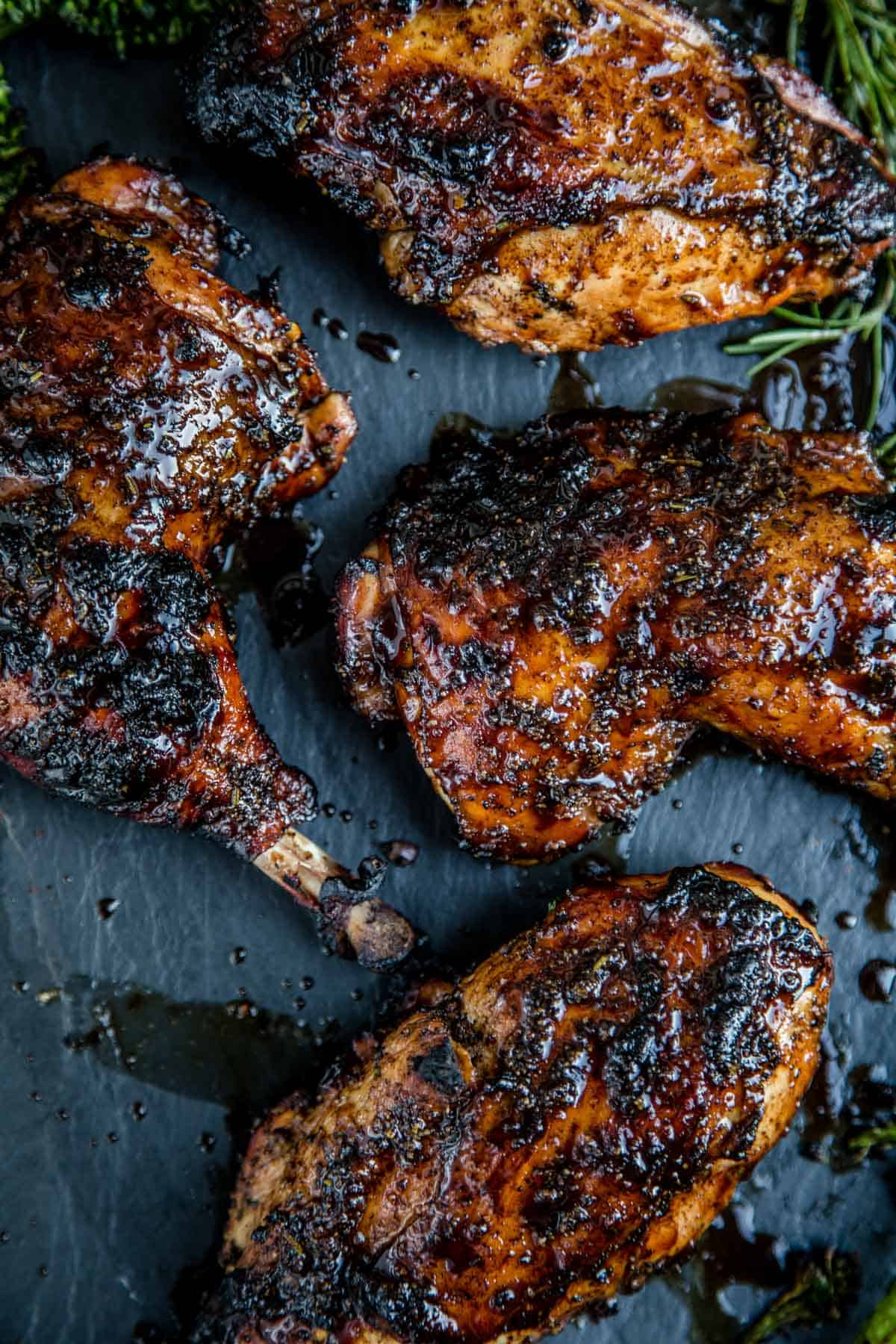
Popular Grilled Chicken Recipes
- Perfect Grilled Chicken Every Time
- Jerk Grilled Chicken
- Grilled Chicken Thighs with BBQ Sauce Glaze
- Ancho Chile Rubbed Chicken with Prune Reduction Sauce
- Grilled Wine Can Chicken
- Blackened Chicken Breast
About Vindulge
Mary (a certified sommelier and recipe developer) and Sean (backyard pitmaster) are co-authors of the critically acclaimed cookbook, Fire + Wine, and have been creating content for the IACP nominated website Vindulge since 2009. They live in Oregon on a farm just outside Portland.
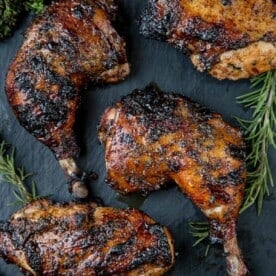
Grilled Balsamic Glazed Chicken Recipe
Ingredients
- 2 whole chicken legs , (thighs and drumstick)
- 2 whole chicken breasts, skin-on
- ¼ cup poultry rub
- 2 tablespoons extra virgin olive oil
Balsamic Glaze
- 1 teaspoon extra virgin olive oil
- 1 tablespoon diced shallots
- 1 clove garlic, diced
- ½ cup balsamic vinegar
- ¼ cup brown sugar
- 2 tablespoons soy sauce
- 1 tablespoon honey
- 2 sprigs rosemary leaves, diced, (about 1 tablespoon)
- 1 teaspoon freshly grated ginger
- ¼ teaspoon kosher salt
Instructions
Balsamic Rosemary Glaze
- In a small sauce pan over medium heat, add olive oil and shallot. Stir often so as to not burn the shallots. This should take about 4 minutes. Add garlic and sauté an additional 1 minute.
- Add remaining glaze ingredients in the pan and stir to incorporate. Bring heat up to medium high and a simmer. Continue to simmer the glaze for an additional 20 minutes or until the glaze has reduced in half.
- Remove the glaze from the heat and allow to cool. As the glaze cools, it will thicken up with the flavors getting more intense. You can place in the refrigerator until ready to use. We recommend doing this prior to starting the grill so it has enough time to cool and thicken.
For the Grilled and Glazed Chicken
- Remove any excess fat from the chicken. Coat chicken in olive oil and liberally apply the poultry seasoning. Can be done up to 24 hours prior to cooking.
- Prepare the grill for two-zone cooking method targeting 450 – 500 degrees ambient cooking temperature in the grill.
- Place the chicken over direct heat on the grill and cook until it gets a nice sear (about 4 minutes with the lid closed). Flip the chicken and grill the other side over direct heat for an additional 4 minutes with the lid closed to get a nice sear on that side. Then move to indirect heat.
- Continue to grill over indirect heat with the lid closed. When the chicken reaches an internal temperature of 150 degrees Fahrenheit (about 8 minutes), glaze the chicken once. Continue to grill over indirect heat and remove from grill when the internal temperature of each piece is at least 165 degrees Fahrenheit.
- Immediately glaze the chicken one last time and let rest 10 minutes loosely tented with foil. Serve with your favorite side.
Notes
Nutrition
Nutrition information is automatically calculated, so should only be used as an approximation.
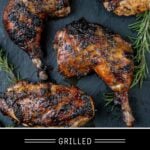
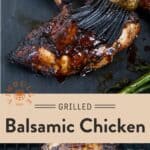
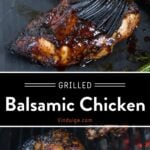
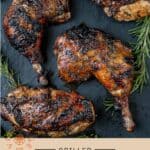
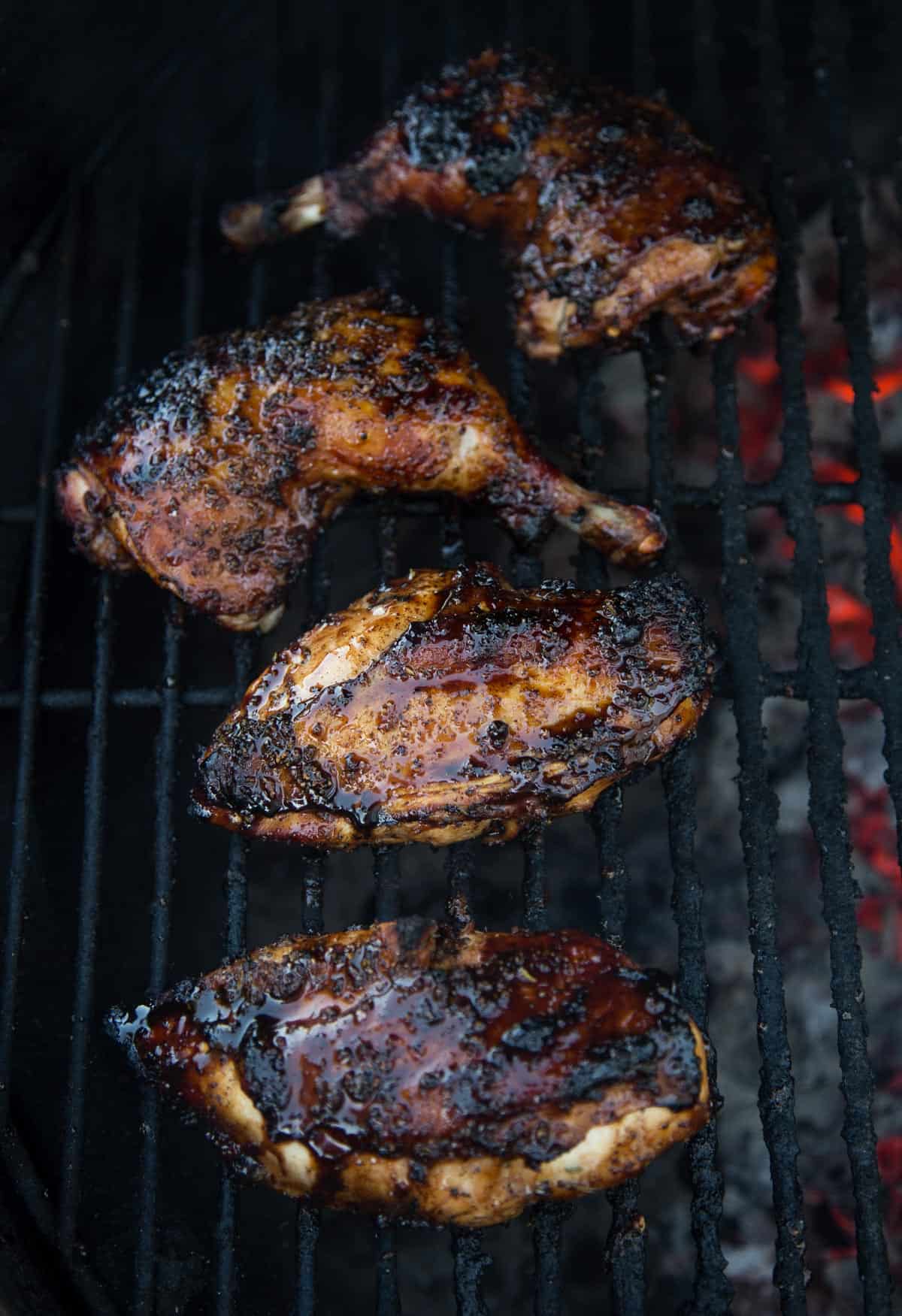


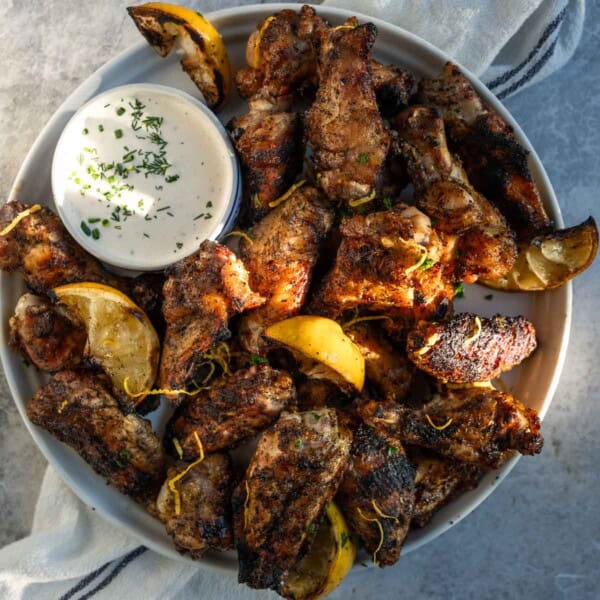
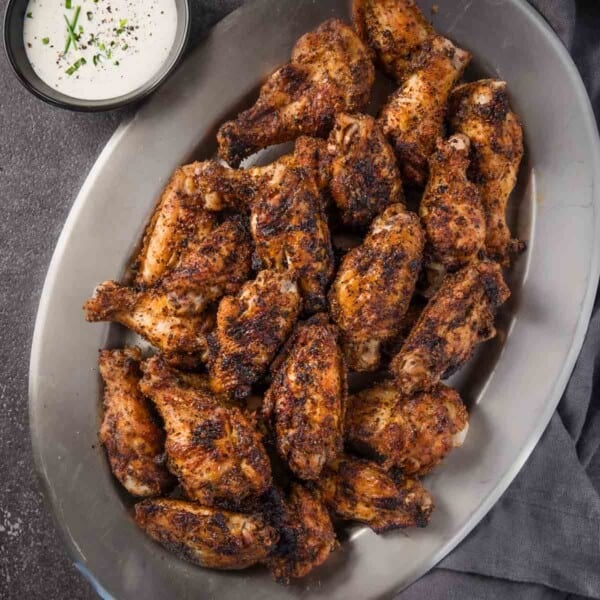
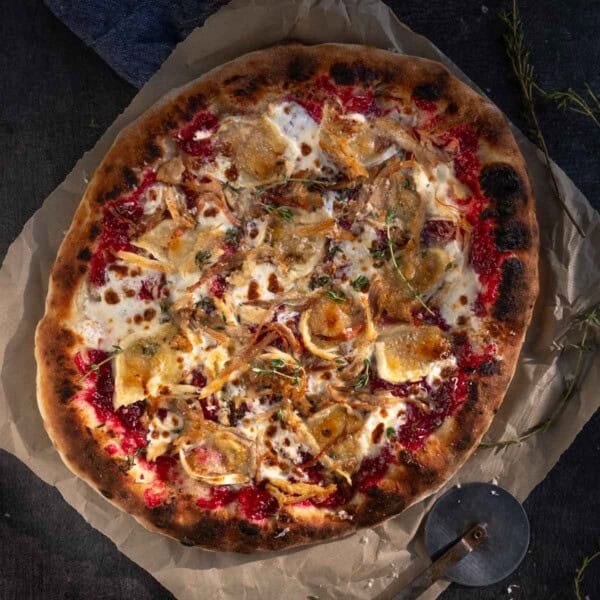
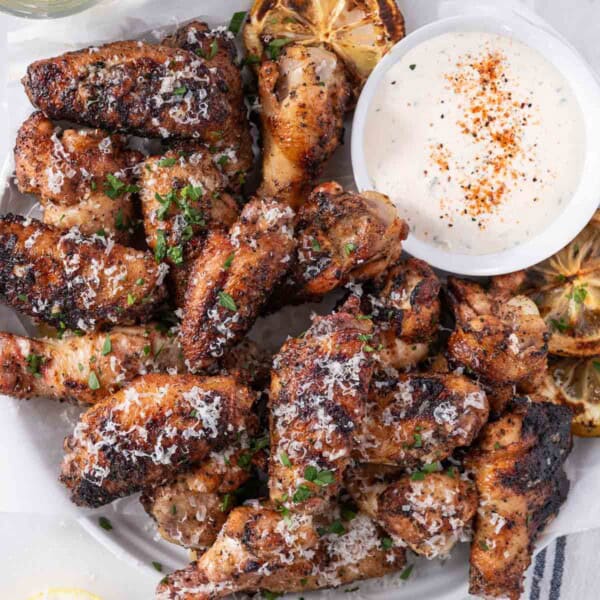

















The flavor that this dry rub imparted on my grilled chicken was more than enough to obtain my “seal of approval,” but what had me “smacking my lips” was the rosemary and balsamic glaze used to coat and finish the chicken.
After taking my first bite, all I could say was, “oh, my!”